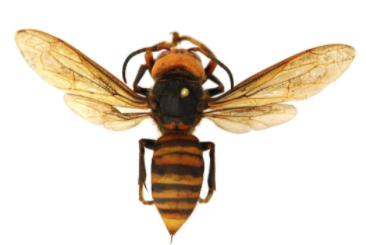Tasty traps go up soon for summer in hopes of halting the invasion and protecting honeybees
BY MARGARET BAUMGARTNER
As summer approaches, the Washington State Department of Agriculture’s (WSDA) hunt for the Asian giant hornet continues with improved traps and help from citizen scientists.
The hornets are an invasive species that were first found in Washington state in December 2019 and can reach a length of two inches. They attack and destroy beehives by beheading bees and taking bee larvae to feed to their own children.
“There’s nothing that really feeds on them. They just feed on everything else whatever they feel like,” said Jon Moore, vice president of the Mt. Baker Beekeepers Association. “We need to stop the hornets from being spread across the United States and get out of control.”
The Asian giant hornets pose a serious threat to honeybees, agriculture and human health. Public involvement has helped to track down and catch the hornets, according to the WSDA Public Engagement Specialist Karla Salp.
Trapping and eradication are important because of the long-term environmental impacts these hornets could cause, Salp said.
The Asian giant hornet is an apex predator and until now has never been in North America. If they get a foothold it could completely disrupt the balance of our ecosystem, according to Ruthie Danielsen, Mt. Baker Beekeepers Association lead coordinator .
“Over 1,200” people hung up and serviced their own traps. which helped [the WSDA] get a better understanding of the situation at hand, WSDA managing entomologist Sven Spichiger said in a press conference on March 1, 2021.
The WSDA has also been receiving help from dozens of what they call “citizen scientists” such as Moore. None of them are actual scientists but they are acting on behalf of the WSDA to do the work that needs to be done to eradicate these hornets by doing things such as setting traps.
“The traps are made of orange juice and rice cooking wine,” Moore said. “About a half a cup of each product in a plastic bottle is hung from a tree about 8 feet in the air to hopefully capture them.”
The orange juice and rice cooking wine is effective because it is good at trapping the hornets while also deterring honeybees, according to Salp.
Now a new method of trap using brown sugar is going to be used by the citizen scientists, according to Spichiger.
“Using this as bait is very exciting for our citizen scientists because OJ and rice wine can be fairly costly, whereas a cup of brown sugar is not all that expensive,” Spichinger said.
According to Moore, the scheduled start for this trap in the WSDA is July 1.
This is a trapping method used to trap the European hornet that has invaded the East Coast of the United States, according to Danielsen.
The reason it took a while to get a more cost-effective trap for public use is because the WSDA wanted to make sure pollinators and insects weren’t being killed as a side effect, according to Spichinger.
“We try to use live traps too to capture one alive and then put trackers on it to follow it back to the nest,” Moore said.
According to Salp, the Asian giant hornets are not yet on the state quarantine agriculture pests list but they have been proposed to be added. Once this is done the WSDA will have legal authority to go on private property for the purpose of removing nests.
WSDA doesn’t want the general public involved in the eradication for safety reasons, according to Moore. If you see a hornet go to the WSDA website to report your sighting. The hornets have been confined mostly to Whatcom county, but the actual count of how many nests there are and where they are is still unknown.
“Our primary goal is to track them and find their nests,” Moore said. “In the end you try to minimize the damage as much as possible.”
